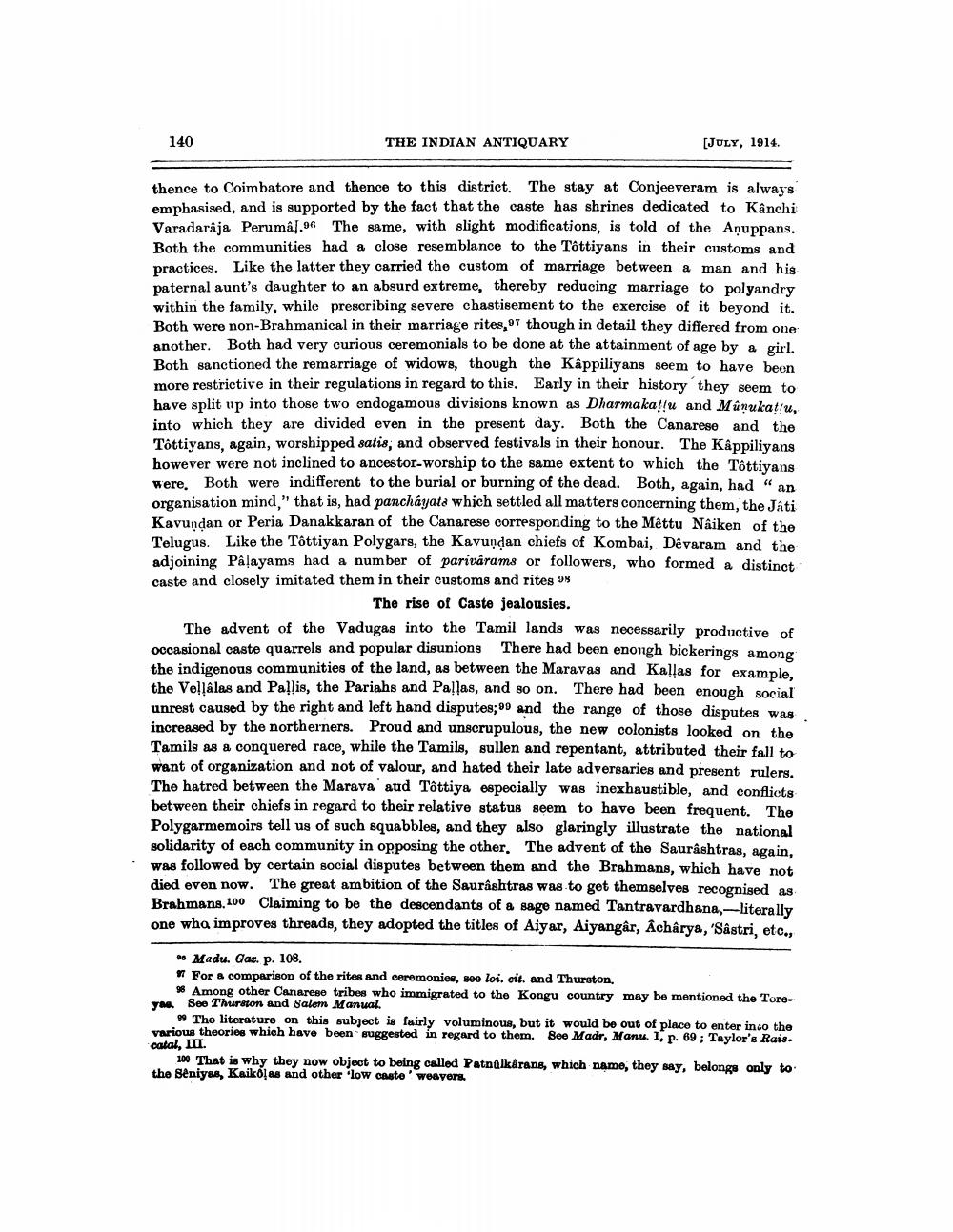________________
140
THE INDIAN ANTIQUARY
[JULY, 1914.
thence to Coimbatore and thence to this district. The stay at Conjeeveram is always emphasised, and is supported by the fact that the caste has shrines dedicated to Kanchi Varadaraja Peruma!.96 The same, with slight modifications, is told of the Anuppans. Both the communities had a close resemblance to the Tóttiyans in their customs and practices. Like the latter they carried the custom of marriage between a man and his paternal aunt's daughter to an absurd extreme, thereby reducing marriage to polyandry within the family, while prescribing severe chastisement to the exercise of it beyond it. Both were non-Brahmanical in their marriage rites, 97 though in detail they differed from one another. Both had very curious ceremonials to be done at the attainment of age by a girl. Both sanctioned the remarriage of widows, though the Kappiliyans seem to have been more restrictive in their regulations in regard to this. Early in their history they seem to have split up into those two endogamous divisions known as Dharmakatlu and Mûnukatu, into which they are divided even in the present day. Both the Canarese and the Tóttiyans, again, worshipped satis, and observed festivals in their honour. The Käppiliyang however were not inclined to ancestor-worship to the same extent to which the Tóttiyans were. Both were indifferent to the burial or burning of the dead. Both, again, had “an organisation mind," that is, had panchayats which settled all matters concerning them, the Játi Kavundan or Peria Danakkaran of the Canarese corresponding to the Mêttu Naiken of the Telugus. Like the Tóttiyan Polygars, the Kavundan chiefs of Kombai, Devaram and the adjoining Palayams had a number of parivarams or followers, who formed a distinct caste and closely imitated them in their customs and rites 0
The rise of Caste jealousies. The advent of the Vadugas into the Tamil lands was necessarily productive of occasional caste quarrels and popular disunions There had been enongh bickerings among the indigenous communities of the land, as between the Maravas and Kallas for example, the Vellalas and Pallis, the Pariahs and Pallas, and so on. There had been enough social unrest caused by the right and left hand disputes; and the range of those disputes was increased by the northerners. Proud and unscrupulous, the new colonists looked on the Tamils as a conquered race, while the Tamils, sullen and repentant, attributed their fall to want of organization and not of valour, and hated their late adversaries and present rulers. The hatred between the Marava aud Tóttiya especially was inexhaustible, and conflicts between their chiefs in regard to their relative status seem to have been frequent. The Polygarmemoirs tell us of such squabbles, and they also glaringly illustrate the national solidarity of each community in opposing the other. The advent of the Saurashtras, again, was followed by certain social disputes between them and the Brahmans, which have not died even now. The great ambition of the Saurashtras was to get themselves recognised as Brahmans.100 Claiming to be the descendants of a sage named Tantravardhana, -literally one who improves threads, they adopted the titles of Aiyar, Aiyangâr, Acharya, 'Sastri, etc.,
• Madu. Gaz. p. 108.
For a comparison of the rites and ceremonies, see loi. cit. and Thurston,
» Among other Canarese tribes who immigrated to the Kongu country may be mentioned the Toroym. See Thurston and Salem Manual
The literature on this subject is fairly voluminous, but it would be out of place to enter inoo the various theories which have been suggested in regard to them. Bee Madr, Manu. I, p. 69; Taylor's Rais. catal, III.
100 That is why they now object to being called Patnolkårans, which name, they say, belongs only to the seniya, Kaiko as and other 'low caste' weavers.




